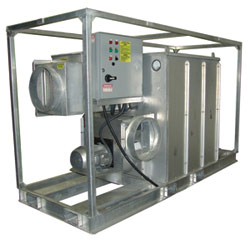Prevent Condensation with Dehumidification
Dehumidification applications work to reduce the amount of moisture in the air to prevent mold and humidity. The uses of these on an industrial level are vast. For example, large gym facilities utilize dehumidifiers to reduce sweat in the air. Any buildup in moisture buildup creates a challenge in the evaporation process. This can result in odor issues and even air quality. Libraries need to prevent mold buildup that can develop on books over time if the humidity is too high. In spaces with large amounts of moisture, unwanted insects like roaches, moths, and fleas can thrive. The need for dehumidifiers in basement-like environments can help to prevent that.
How Does Condensation Occur?
There is a science behind indoor moisture that often leads to extremely humid conditions. When warm air combines with a surface or object that is cooler, the moisture developed from this interaction turns into visible water. This is why when you place heat into a closed environment, steam or water pellets begin to form. Facilities without proper insulation are susceptible to developing large amounts of water that can lead to hazardous chemicals that can destroy the foundation and walls of the structure.
Excess moisture in the air can lead to health consequences such as:
- Allergies
- Mold and mildew
- Bad air quality
- Unpleasant odors
- Foggy windows, walls, and water pipes
Maintenance of Dehumidifiers
Since dehumidifiers are generally rented, maintenance is usually handled by the owner. However, it is wise to be aware of the amount of dust present so as to prevent the obstruction of airflow. The importance of having sturdy filters is vital and will save you time and money. In addition, the dehumidification process essentially takes moisture from the air. As a result, the water consumed needs to be cleaned and discarded in order to prevent damage. Be sure to speak with your rental company to learn what filters you will need and how to empty the machine.
The Different Types of Dehumidifiers
When considering the type of dehumidifier to purchase, it is essential to consider these three points: the size of the facility, the amount of energy being used by the unit, and how much maintenance it requires. Although changing filters and emptying excess water may seem relatively easy, larger units may require more effort. There are several models on the market that work to eliminate condensation in the environment at various levels. The 15000 CFM Desicant Dehumidifier, for example, is a large scale option that can run off either gas or electric fuel. It comes with a personalized trailer to mount the generators and can prove to be an excellent addition to bigger spaces. The P1200 Desiccant Dehumidifier is a smaller portable option that is specifically designed to work in the restoration industry. Although small, this unit is able to take away 43 gallons of water on a daily basis.
If you live in a humid area or work in an industry where humidity can play havoc with your schedule, a dehumidifier can be incredibly handy to have around. The dangers of being exposed to excess amounts of humidity, mold, and mildew can be detrimental. The key is the research the best options for your company and implement theses systems into your costs.

